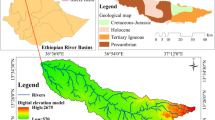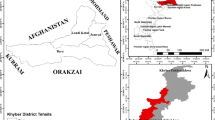Abstract
Irrigation plays a vital role to increase agricultural productivity and improve the livelihoods of the communities specifically and the economy of Ethiopia in general. However, there are gaps in development of irrigation schemes and irrigation practice. Therefore, land suitability evaluation is critical to identify the potential lands for surface irrigation. The aim of the study was to identify suitable lands for surface irrigation in Rib–Gumara watershed using remote sensing and GIS-based multicriteria evaluation techniques. The main criteria used in the study were land-use/land-cover (LULC), distance to rivers, slope, and soil physical and chemical properties like soil type, texture, drainage, depth, cation exchange capacity, electrical conductivity (ECe), pHs and exchangeable sodium percentage. The LULC types were extracted from Landsat 8 image using a maximum likelihood classifier. Surface analysis was used to extract slope factor from ASTER DEM, and watershed analysis was also employed to delineate watershed and extract rivers which are drained in the watershed. Likewise, Euclidean distance spatial analysis was also utilized to evaluate the distance of rivers to the potential land. Finally, each criterion was standardized and the analytical hierarchy process was applied to develop suitable irrigation land. The irrigation land suitability was ranked as highly suitable (S1), moderately suitable (S2), marginally suitable (S3) and not suitable (N1). Cross-tabulation was also done to understand the contribution of each factor to suitable irrigation land. The results of study show that 971.37 km2 (27.55%) of the area of the watershed was highly suitable, whereas 2291.28 km2 (64.99%) of the area was moderately suitable, 72.34 km2 (2.05%) was marginally suitable and 190.46 km2 (5.4%) was not suitable. Therefore, the government should intensively work and launch different irrigation scheme projects to utilize these potential irrigation lands of Rib–Gumara watershed.





Similar content being viewed by others
References
Adewumi, J. R., Ejeh, O. J., Lasisi, K. H., & Ajibade, F. O. (2019). A GIS–AHP-based approach in siting MSW landfills in Lokoja, Nigeria. SN Applied Sciences. https://doi.org/10.1007/s42452-019-1500-6
Adhikary, P. P., Chandrasekharan, H., Trivedi, S., & Dash, C. J. (2015). GIS applicability to assess spatio-temporal variation of groundwater quality and sustainable use for irrigation. Arabian Journal of Geosciences , 8, 2699–2711.
Akinci, H., Ozalp, A. Y., & Turgut, B. (2013). Agricultural land use suitability analysis using GIS and AHP technique. Computers and Electronics in Agriculture, 97, 71–82.
Araya, A., & Stroosnijder, L. (2011). Assessing drought risk and irrigation need in northern Ethiopia. Agricultural and Forest Meteorology, 151, 425–436.
Assefa, T., Jha, M., Reyes, M., Srinivasan, R., & Worqlul, A. (2018). Assessment of suitable areas for home gardens for irrigation potential, water availability, and water-lifting technologies. Water, 10, 495.
Awulachew, S. B., & Ayana, M. (2011). Performance of irrigation: Assessment at different scales in Ethiopia. Experimental Agriculture, 47(Suppl 1), 57–69.
Awulachew, S.B., Erkossa, T., Namara, R. (2010). Irrigation potential in Ethiopia, Constraints and opportunities for enhancing the system. International Water Management Institute. https://doi.org/10.21955/GATESOPENRES.1114943.1.
Awulachew, S.B., Merrey, D.J., Kamara, A.B., Van Koppen, B., Penning de Vries, F., Boelee, E., Makombe, G. (2005). Experiences and opportunities for promoting small-scale/micro irrigation and rainwater harvesting for food security in Ethiopia. International Water Management Institute Working Paper 98, Colombo, Sri Lanka.
Awulachew, S.B., Yilma, A.D., Loulseged, M., Loiskandl, W., Ayana, M., Alamirew, T. (2007). Water resources and irrigation development in Ethiopia. International Water Management Institute, Working Paper 123, Colombo, Sri Lanka. https://doi.org/10.3910/2009.305.
Ayalew, G. (2014). Land suitability evaluation for surface and sprinkler irrigation using geographical information system (GIS) in Guang Watershed, highlands of Ethiopia. Journal of Environmental and Earth Sciences, 4, 140–149.
Balew, A., Alemu, M., Leul, Y., & Feye, T. (2020). Suitable landfill site selection using GIS-based multi-criteria decision analysis and evaluation in Robe town, Ethiopia. Geo Journal. https://doi.org/10.1007/s10708-020-10284-3
Berry, L., 2003. Land degradation in Ethiopia: Its extent and impact (Commissioned by the Global Mechanism with World Bank support). http://rmportal.net/library/content/frame/land-degradation-case-studies-03-ethiopia/at-download/.
Bewket, W., & Conway, D. (2007). A note on the temporal and spatial variability of rainfall in the drought-prone Amhara region of Ethiopia. International Journal of Climatology, 27, 1467–1477.
Birhanu, A., Pingale, S. M., Soundharajan, B., & Singh, P. (2019). GIS-based surface irrigation potential assessment for Ethiopian River Basin. Irrigation and Drainage. https://doi.org/10.1002/ird.2346
Chen, Y., Yu, J., & Khan, S. (2010). Spatial sensitivity analysis of multi-criteria weights in GIS-based land suitability evaluation. Environmental Modelling and Software, 25, 1582–1591.
Chen, Y., Yu, J., Shahbaz, K., Xevi, E. (2009). A GIS-Based Sensitivity Analysis of Multi-Criteria Weights. In: Anderssen, R.S., R.D. Braddock and L.T.H. Newham (eds.), Proceedings of the 18th World IMACS Congress and MODSIM09 International Congress on Modelling and Simulation. Modelling and Simulation Society of Australia and New Zealand and International Association for Mathematics and Computers in Simulation (pp. 2377–2383). Cairns, Australia, 13–17 July 2009.
Critchley, W., Siebert, K., Chapman, C. (1991). Water harvesting: A manual for the design and construction of water harvesting schemes for plant production. Water harvesting (AGL/MISC/17/91), FAO, Rome, Italy. http://www.fao.org/3/U3160E/U3160E00.htm.
CSA. (2013). Population projection of Ethiopia for all regions at Wereda Level from 2014–2017 (Population projection). Federal Democratic Republic of Ethiopia Central Statistical Agency.
Elsheik, A. R., Ahmad, N., Shariff, A., Balasundra, S., & Yahaya, S. (2010). An agricultural investment map based on geographic information system and multi-criteria method. Journal of Applied Sciences, 10, 1596–1602.
FAO, (1997). Irrigation potential in Africa: A basin approach. FAO land and water bulletin 4, FAO: Rome, Italy.
FAO, (1985). Guidelines: Land evaluation for irrigated agriculture. FAO soils bulletin No. 55. Rome, Italy.
FAO, (1981). Guidelines for designing and evaluating surface irrigation systems. FAO irrigation and drainage paper 45, Rome, Italy.
FAO and UNESCO, (1988). Soil map of the world, revised legend, with corrections and updates. World soil resource report No. 60. FAO, Rome, Italy.
Hammond, M., (2013). The Grand Ethiopian renaissance dam and the Blue Nile: implications for transboundary water governance. Global water forum discussion paper, (vol 1307). https://globalwaterforum.org/2013/02/18/the-grand-ethiopian-renaissance-dam-and-the-blue-nile-implications-for-transboundary-water-governance/.
Hussien, K., Woldu, G., & Birhanu, S. (2019). A GIS-based multi-criteria land suitability analysis for surface irrigation along the Erer Watershed, Eastern Hararghe Zone, Ethiopia. East African Journal of Sciences, 13, 169–184.
Jha, M. K., Chowdary, V., & Chowdhury, A. (2010). Groundwater assessment in Salboni Block, West Bengal (India) using remote sensing, geographical information system and multi-criteria decision analysis techniques. Hydrogeology Journal, 18, 1713–1728.
Kebede, T., & Ademe, Y. (2016). Evaluating land suitability for irrigation purposes in the Abaya district, Borena zone, Ethiopia. African Journal of Agricultural Research, 11, 4754–4761.
Latinopoulos, D., Theodossiou, N., & Latinopoulos, P. (2011). Combined use of groundwater simulation and multi-criteria analysis within a spatial decision-making framework for optimal allocation of irrigation water. Spanish Journal of Agricultural Research, 9, 1105–1119.
Lillesand, T., Kiefer, R. W., & Chipman, J. (2014). Remote sensing and image interpretation. Wiley.
Mahari, A., & Alebachew, A. (2013). Land suitability evaluation for irrigation in Dejen District, Ethiopia. International Journal of Scientific and Research Publications, 3(9), 1–3.
Malczewski, J., (2006a). Integrating multicriteria analysis and geographic information systems: the ordered weighted averaging (OWA) approach. International Journal of Environmental Technology and Management, 6 (1/2), 7–19.
Malczewski, J. (2006b). GIS-based multicriteria decision analysis: a survey of the literature. International Journal of Geographical Information Science, 20, 703–726.
Mandal, B., Dolui, G., & Satpathy, S. (2017). Land suitability assessment for potential surface irrigation of river catchment for irrigation development in Kansai watershed, Purulia, West Bengal, India. Sustainable Water Resources Managements, 4, 699–714.
Mendas, A., & Delali, A. (2012). Integration of multicriteria decision analysis in GIS to develop land suitability for agriculture: Application to durum wheat cultivation in the region of Mleta in Algeria. Computers and Electronics in Agriculture, 83, 117–126.
Nachtergaele, F., Van, H.V., Verelst, L., Batjes, N., Dijkshoorn, K., Van, V.E., Fischer, G., Jones, A., Montanarella, L., Petri, M., Prieler, S., Teixeira, E., Wiberg, D., Shi, X. (2009). Harmonized world soil database (version 1.1). FAO, Rome, Italy. http://www.fao.org/fileadmin/templates/nr/documents/HWSD/HWSD_Documentation.pdf.
Nasir, G. T., Tamane, A. D., & Tolera, D. F. (2019). Irrigation potential assessment on Shaya River Sub-Basin in Bale Zone, Oromia Region, Ethiopia. Irrigation & Drainage Systems Engineering. https://doi.org/10.4172/2168-9768.1000225
Negash, W., & Seleshi, B. (2004). GIS based irrigation suitability analysis. Journal of Water Science and Technology, 8, 55–61.
Seleshi, Y., & Camberlin, P. (2006). Recent changes in dry spell and extreme rainfall events in Ethiopia. Theoretical and Applied Climatology, 83, 181–191.
Steuer, R. E., & Na, P. (2003). Multiple criteria decision making combined with finance: A categorized bibliographic study. European Journal of Operational Research, 150, 496–515.
Sultan, D. (2013). Assessment of irrigation land suitability and development of map for the Fogera catchment using GIS, South Gondar. Asian Journal of Agriculture and Rural Development, 3, 7–17.
Teshome, A., Halefom, A., (2020). Potential land suitability identification for surface irrigation: In case of Gumara watershed, Blue Nile basin, Ethiopia. Modeling Earth Systems and Environment. 6, 929–942. https://doi.org/10.1007/s40808-020-00729-6.
USDIBR (United State Department of the Interior Bureau of Reclamation), (2003). Technical guidelines for irrigation suitability land classification. United State Department of the Interior Bureau of Reclamation, Technical service center, land suitability and water quality group Denver, Colorado. https://www.usbr.gov/tsc/techreferences/mands/mands-pdfs/TechnicalGuidelinesForIrrigationSuitabilityLandClass_2005.pdf.
Wale, A., Collick, A.S., Rossiter, D.G., Langan, S., Steenhuis, T.S. (2013). Realistic assessment of irrigation potential in the Lake Tana basin, Ethiopia. In W. Mekuria (Ed.), Rainwater Management for Resilient Livelihoods in Ethiopia: Proceedings of the Nile Basin Development Challenge Science Meeting, Addis Ababa, 9–10 July 2013. NBDC Technical Report 5. Nairobi, Kenya: International Livestock Research Institute.
Worqlul, A. W., Collick, A. S., Rossiter, D. G., Langan, S., & Steenhuis, T. S. (2015). Assessment of surface water irrigation potential in the Ethiopian highlands: The Lake Tana Basin. CATENA, 129, 76–85.
Worqlul, A. W., Jeong, J., Dile, Y. T., Osorio, J., Schmitter, P., Gerik, T., Srinivasan, R., & Clark, N. (2017). Assessing potential land suitable for surface irrigation using groundwater in Ethiopia. Applied Geography, 85, 1–13.
Yitbarek, T., Kibret, K., & Beyene, S. (2017). Physical land suitability evaluation for irrigation in the lower Alwero River Area of Abobo, Western Ethiopia. American Journal of Agricultural and Forestry, 5, 60–64.
You, L., Ringler, C., Wood-Sichra, U., Robertson, R., Wood, S., & Zhu, T. (2011). What is the irrigation potential for Africa? A combined biophysical and socioeconomic approach. Food Policy, 36, 770–782.
Acknowledgements
The authors thank Amhara Design and Supervision Works Enterprise (ADSWE) for providing soil dataset. We also thank United States Geological Survey (USGS) for providing Landsat image and ASTER DEM freely for the study.
Author information
Authors and Affiliations
Corresponding author
Additional information
Publisher's Note
Springer Nature remains neutral with regard to jurisdictional claims in published maps and institutional affiliations.
About this article
Cite this article
Balew, A., Nega, W., Legese, B. et al. Suitable Potential Land Evaluation for Surface Water Irrigation Using Remote Sensing and GIS–MCE in the Case of Rib–Gumara Watershed, Ethiopia. J Indian Soc Remote Sens 49, 2273–2290 (2021). https://doi.org/10.1007/s12524-021-01383-w
Received:
Accepted:
Published:
Issue Date:
DOI: https://doi.org/10.1007/s12524-021-01383-w




